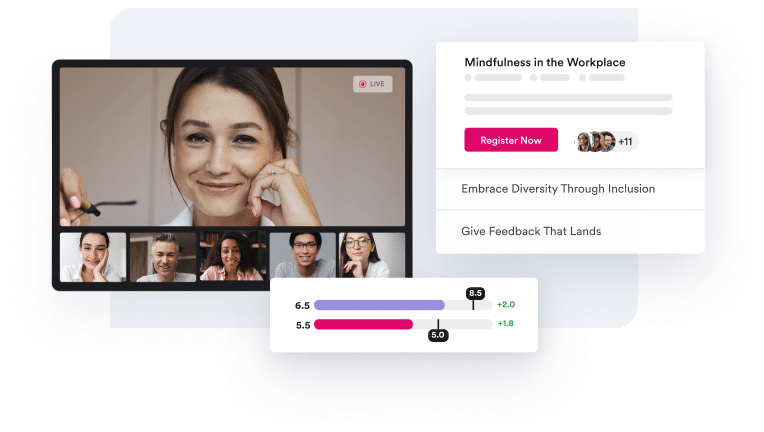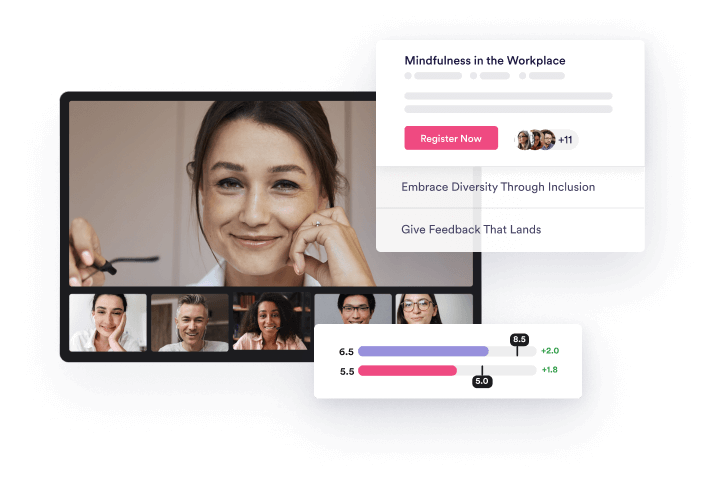Finding and attracting top talent is one of the top challenges for every organization. And once you identify your all-star team and bring them on board, you must do your best to keep them. But, unfortunately, with the move to hybrid workplaces, in-person perks like fancy coffee, nap pods, dry cleaning drop-off, and in-office chair massages no longer move the needle.
But all hope is not lost. There’s another perk that research shows job holders and seekers still value: growth and development opportunities. And since you already want to ensure they reach their full potential, it also benefits the company.
Talent development doesn’t happen on its own, however. It would be best if you prioritized their development. And increasingly, learning and development teams are under pressure to measure the ROI of their efforts, so now is the time to cast a wide net when considering investing in employee growth.
Why Develop Talent in Your Organization?
Besides recruiting and retaining talent, providing workforce growth and development benefits also impacts your organization’s bottom line. Organizations with robust growth and development offerings enjoy higher profit margins and generate higher income per employee than those without. This makes sense when considering this startling statistic from Gartner: 70% of workers say they haven’t mastered the skills they need for their jobs.
Development-focused organizations also invest in organizational sustainability and succession planning alongside their commitment to training. For example, IBM conducted a workplace study and found that only 24% of the original employees remained with the company by year six. The rest took their skills, capabilities, and knowledge with them. Development and growth provide a critical mechanism to offset this attrition by communicating and sustaining organizational mission, values, and culture.
How to Invest in Employees
Given the critical importance of investing in employees, how does that translate into an organization’s day-to-day operations? At Hone, we believe successful investment in employee growth is built upon three key components–training, culture, and practice. You need all three to support each other and sustainably bake development into your organization.
Investing in Employees through Training
Training is a clear and recognizable benefit companies can offer to show commitment to employee development. Below are some best practices for building your training offerings to deliver on employee growth goals.
Invest in both internal and external training.
When developing a learning and development roster of programs, offer a blend of in-house and external offerings. Internal training educates the workforce on your organization’s philosophy, values, and mission while allowing colleagues to share their expertise.
External programs complement internal offerings, often providing new insight, a fresh perspective, and skill-building expertise that can’t be offered internally. In addition, leveraging external training experts and offerings demonstrates a company’s commitment to learning and its employees.
Encourage balanced development
We often identify top talent based on specific strengths and skill sets they’ve displayed. For example, an individual might be a fantastic wordsmith or excel at data analytics. Seeing their aptitude in those areas, a company might decide to provide further training in those domains.
However, if you want to invest in an employee, you’ll help them develop skills in other areas. That way, they can minimize their weaknesses and become more well-rounded. In turn, they will likely become better managers and avoid relying solely on their core strengths.
Develop learning tracks for multiple career stages
Many organizations offer some form of new manager training, as well as some targeted skills training. While these classes are essential, developing learning tracks for colleagues at every level demonstrates the company’s commitment to continuous learning.
When your boss and the department head attend training and discuss what they learned with their teams, it telegraphs that development is for everyone. That helps you provide a meaningful benefit to all your workers, not just the new managers.
Measure the ROI of your employee development efforts
More learning and development teams get asked to quantify the impact of the budget spent on training. It is worth doing if you truly live the values of allowing for failure and have embraced a continuous learning mindset. By measuring your efforts’ ROI, you can abandon programs that aren’t serving your employees and seek out ones they will value. At Hone, we believe in measuring the ROI of your learning and development, so we wrote an ebook about it!
Developing an Employee Growth Culture
Organizations that value and invest in employees embed this value into their company culture. Training is the classroom component, the practice uses the skills, and culture provides the support and focuses needed to instill long-term, sustainable employee growth.
Reinforce Organization Values, Mission, and Purpose
You want your future managers and top talent to display values aligned with the company’s values. Moreover, they should understand and embrace the firm’s mission and recognize their job’s role in fulfilling those goals. This enables everyone to see the relative importance of their position. In addition, it affirms the company’s values while making it easier to relay them to others.
Build a Culture of Mentorship
If you want to see your employees flourish, you’ll build a culture of mentorship. This allows your company to become a place of connection and growth. Moreover, it signals that you care about your workers’ professional aspirations. And in turn, this builds loyalty among your top talent when they see the company’s commitment to their individual development.
Allow for Failure
Even your most ambitious employees might hesitate to take on a challenging task if they know there’s a high risk of failure. They may fear it will poorly reflect their performance and impede their trajectory. However, for top talent to truly develop, they must tackle stretch assignments. So please encourage them to push themselves and test their capabilities. Part of doing new things is learning how to cope with stressful situations and deal with setbacks, so trust in the resilience of your top performers and check in to make sure they’re on track.
9 Best Practices for Developing Top Talent
1. Emphasize The Importance of Learning
The best leaders are often individuals who place a premium on learning. Their curiosity fosters continual growth and forces them to evaluate where their knowledge gaps may lay routinely. As a result, it’s easier for them to overcome problems, accomplish complex tasks, and set new goals.
2. Allow for Failure
Even your most ambitious employees might hesitate to take on a challenging task if they know there’s a high risk of failure. Understandably, they fear it will reflect poorly on their overall performance and potentially impede their trajectory. However, for top talent to truly develop, they must tackle stretch assignments. And they should push themselves to test their capabilities. After all, they must learn how to cope with stressful situations and setbacks.
3. Build a Culture of Mentorship
If you genuinely want to see your employees flourish, you’ll build a culture of mentorship. This will allow your company to become a place of connection and growth. Moreover, it’ll signal that you care about your workers’ professional aspirations. And, in turn, your top talent will be more loyal to your company.
4. Encourage Balanced Development
We often identify top talent based on specific strengths and skill sets they’ve displayed. For example, an individual might be a fantastic wordsmith or excel at data analytics. And those areas where a company might decide to provide further training. However, if you want to invest in an employee, you’ll help them develop skills in other areas. That way, they can hone their weaknesses and become more well-rounded. They will likely become better managers relying solely on their core strengths.
5. Reinforce Values and Missions
You want your future managers and top talent to display values that align with the company. Moreover, they should fully understand and embrace the firm’s mission and recognize their job’s rolling those goals. This allows everyone to see the importance of their position. And it affirms the company’s message and makes it easier to relay.

6. Hold Regular Reviews/Evaluations
It’s critical to check in with your employees at regular intervals. This way, you can assess their progress and see their feelings. Are they happy? Are they feeling stymied? You can discuss their personal growth and evaluate their vision for their professional future. Additionally, this offers you the opportunity to provide invaluable feedback. You may address performance metrics and illuminate areas in which they are excelling and those in which they might need improvement.
may address performance metrics and illuminate areas in which they are excelling and those in which they might need improvement.
7. Offer Assignments Beyond Their Purview
Many companies divide their organization by department and function. Employees fill a specific role and don’t expand beyond their job description. However, if you want an individual to eventually move up the ranks, they need exposure to other areas of the company. Create opportunities for them to tackle responsibilities beyond their actual job function. This will increase their understanding of the overall office, widen their skill set and strengthen their communication with secondary colleagues.
8. Provide External Resources
If you want to develop your talent, you need to invest in your talent. That can mean turning to outside organizations for additional education or certification. These programs often provide new insight, a fresh perspective, and training that can’t be offered internally. They underscore a company’s commitment to learning and their employees even better.
9. Make Introductions
To see your top talent truly excel, help them network. Make introductions and connect them with colleagues who will be additional role models and mentors. This allows your top talent to bolster industry relationships and enhance their expertise. Best of all, it will likely encourage them to open doors with their subordinates.
—
Invest in your employees if you genuinely want to develop your top talent. That often involves tapping into external programs that help them hone their leadership skills.









